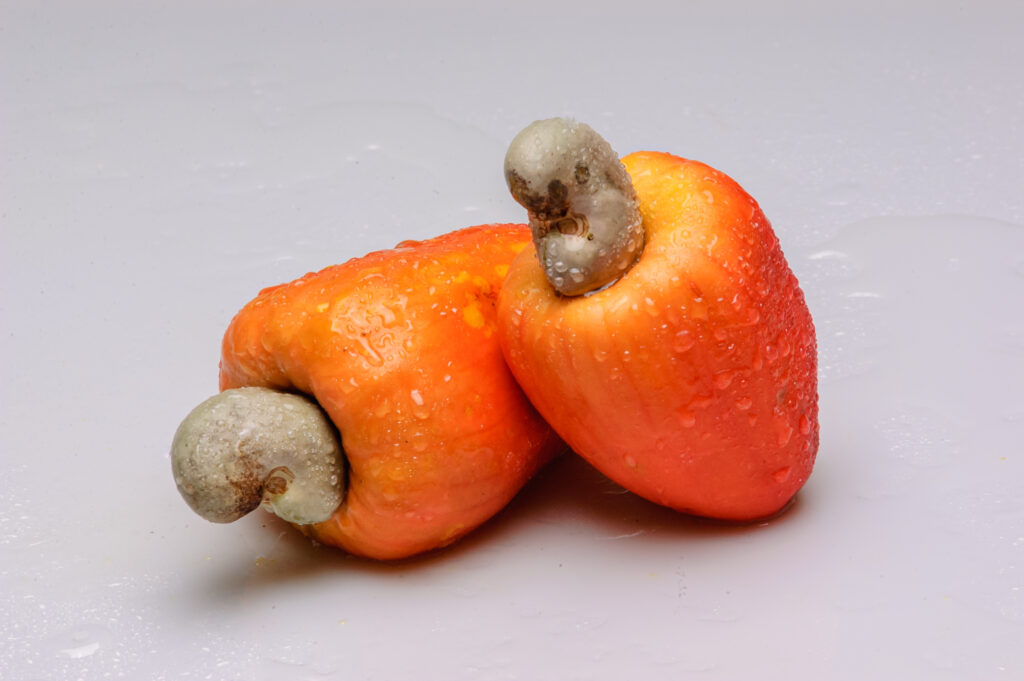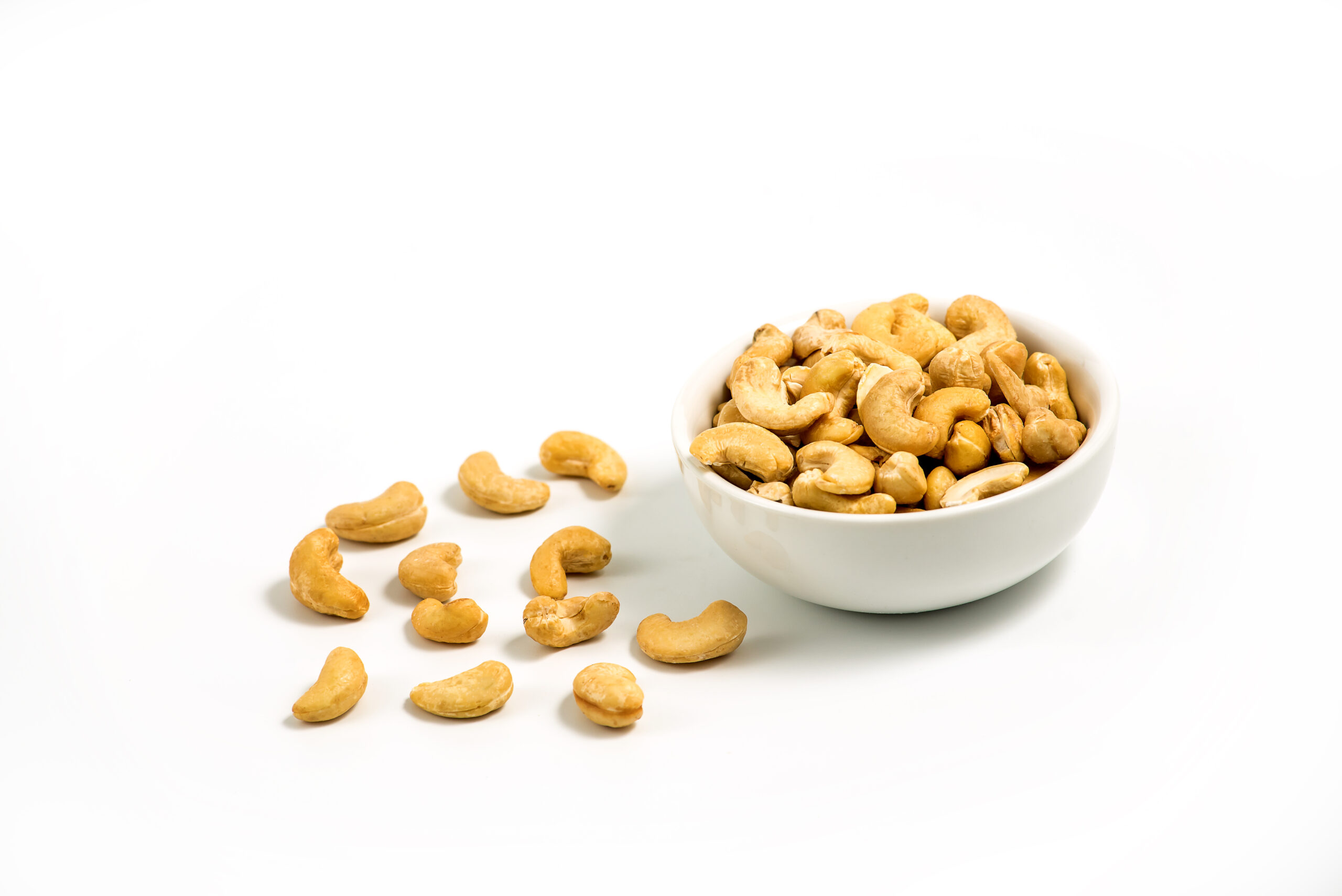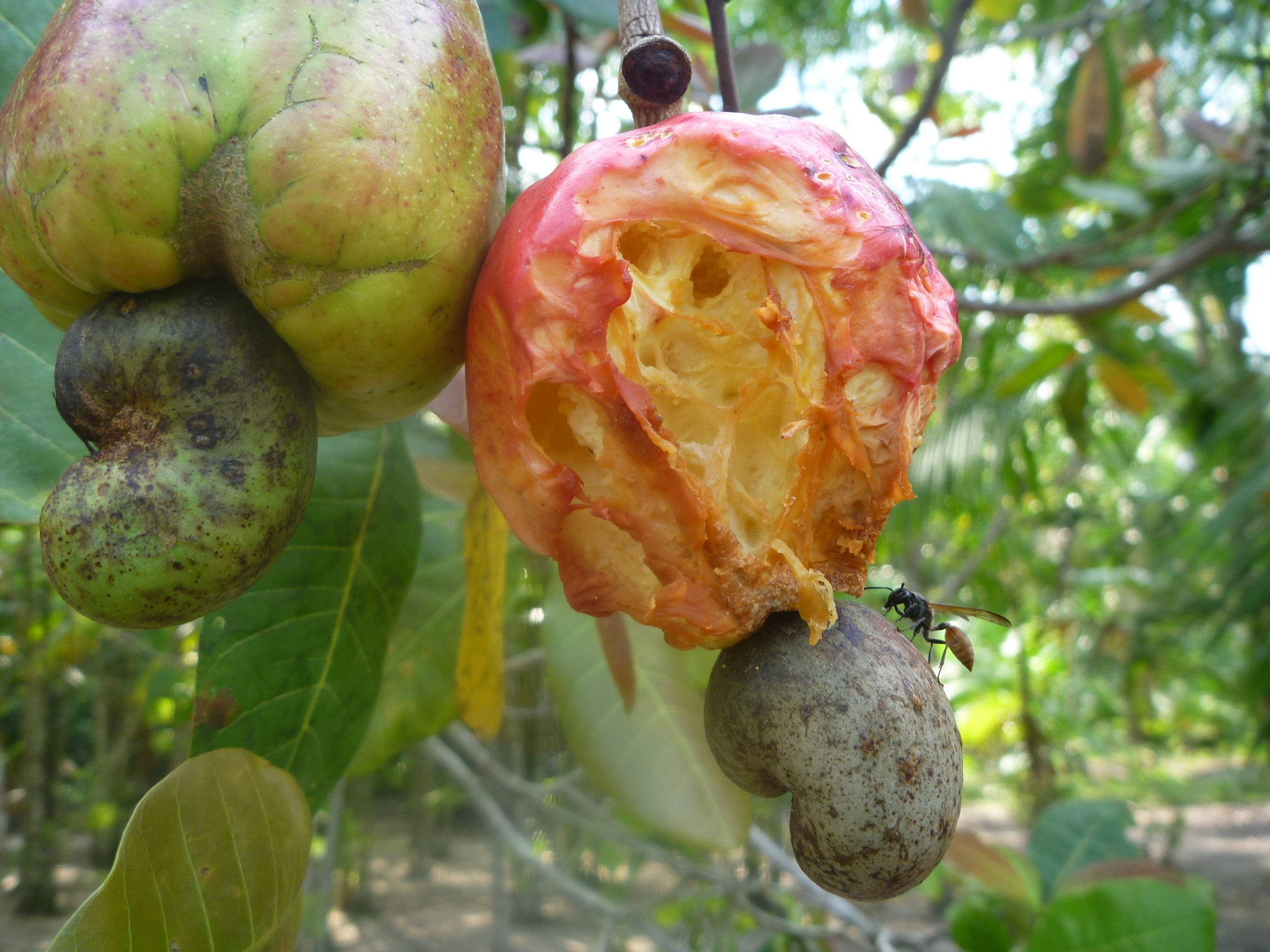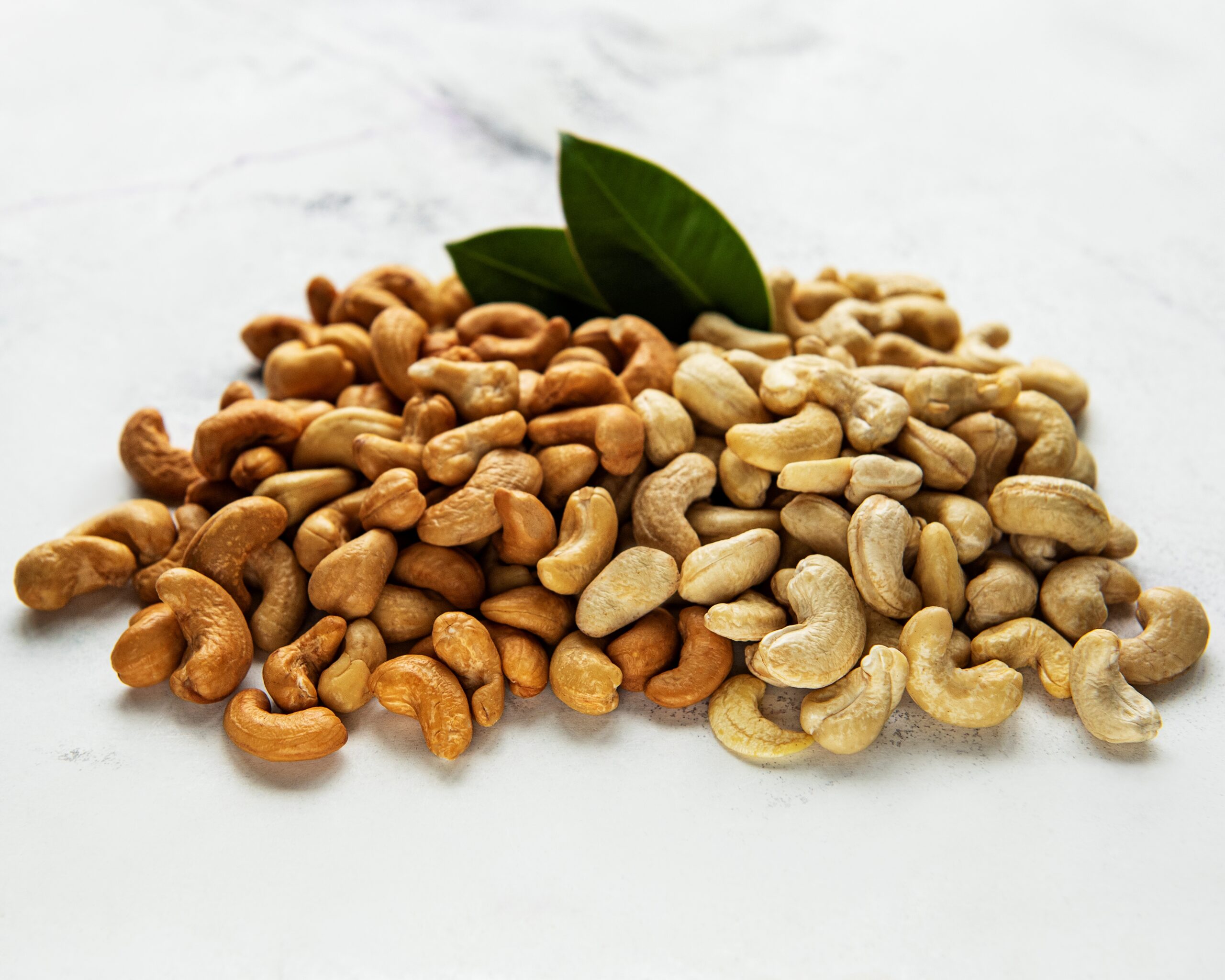Cashew
General information
The cashew tree (Anacardium occidentale L.) originally comes from Brazil. Just like the Brazil nut, the kernels of the plant are not nuts from a purely botanical point of view, but nut-like drupes.
What are the characteristics of this tree? It can reach a height of up to 14 metres and its leaves are leathery and oval. The fruits of the cashew tree are pear-shaped and have a hard-shelled stone with a cashew kernel inside. Between the 5 mm thick shell and the cashew kernel is a black corrosive oil, which causes difficulties and risks in further processing. Cashew nuts are in such high demand mainly because of their health benefits: they are rich in carbohydrates, unsaturated fats, minerals such as calcium, phosphorus and iron as well as vitamins.

Growing regions
The countries marked in the map below are the main cashew growing areas. These are measured by the amount of cashew nuts produced annually; altogether around 130,000 tonnes in 2021, according to data from the Food and Agriculture Organization (FAO). West African countries are among the main producers, exporting almost half of the products on the world market.
The primary African producing countries are Benin, Burkina Faso, Ghana, Guinea, Mali, Mozambique, Nigeria, Tanzania and Ivory Coast, while the main growing regions in Asia include India, Vietnam, Indonesia and the Philippines. Cashew trees are also cultivated in Brazil.
Cultivation and harvest
When growing cashews, pits are dug in a field and filled with manure and soil. Planting takes place at the beginning of the monsoon season, i.e. from May to June. When cashews are ripe, they naturally fall to the ground. Farmers usually wait for this point and collect the fallen fruit from the ground. Harvesting and further processing are very labour-intensive. In two to 20% of cases in West Africa, shelling of the kernels is done manually by women. The remaining processing methods, however, are partially automated.


Products
All parts of the cashew plant can be used, but not all are edible. Cashews can be consumed as a pure snack, roasted and salted, or used in baked goods. The cashew apple is very rich in vitamin C. However, since it begins to rot very quickly after it ripens, it is not traded internationally. In the countries where cashews are grown, for example, alcoholic drinks are made from cashew apples.
Is there anything negative about cashews? Unfortunately yes! Cashew shell oil is extremely caustic and therefore not suitable for consumption. It is used, for example, in the automotive industry for brake pads or in paints.
Consumption
The USA and Europe maintain a constant demand for cashews. Since the 1990s, consumption has also increased in China, Russia, Eastern Europe and the Middle East. The reasons for this growth are the cashew’s nutritional value, which makes consumption appealing, and the increased world population.


Challenges
Climate change has a direct impact on cashew production. This is noticeable in changes in the annual amount of precipitation, later rainy seasons, longer drought periods, more extreme weather conditions and extremely high temperatures. For the cashew, this means that the plants dry out faster and that their leaves and flowers or even the entire fruits fall off, reducing their yields.
Adaptation measures are therefore necessary to cushion the effects of climate change and to secure the incomes of people for whom cashews are an important source of livelihood. There are various approaches to achieving this.
Um hohe Erträge zu sichern, ist es essentiell, die Widerstandskraft gegen beide Extreme, starke Regenfälle und lange Dürreperioden, zu stärken. Dafür sind organische Substanzen im Boden, vergleichbar mit Humus, von Bedeutung. Diese stellen sicher, dass der Boden an Stabilität gewinnt und Wasser besser absorbiert werden kann. Dadurch sinkt die das Risiko von Erosionen bei Starkregen. Auch in Dürreperioden sind die organischen Substanzen von Vorteil, da die Fähigkeit zur Speicherung von Wasser verbessert wird.
Das Wissen lokaler Landwirt:innen ist in der Kultivierung von Cashews unersetzlich. Bewährt haben sich das Mulchen (organisches Material wie Pflanzenreste, das auf dem Boden verteilt wird), das Düngen oder die Bewässerung. Diese Maßnahmen verbessern die Fruchtbarkeit bzw. die Feuchtigkeit des Bodens und steigern dadurch den Ernteertrag. Jedoch ist es aufgrund des schwierigen Zugangs zu Wasserressourcen für einige Produzent:innen nicht oder nur schwer möglich, ihre Felder zu bewässern.
Certification
When purchasing cashews, one should pay attention and look out for an organic and fair trade label. If one is still unsure about the working conditions, it makes sense to find out more directly from the providers. So-called „blood cashews“, the result of child labour and health-endangering practices, are certainly not worth consuming.

Vor allem das Cashewschalenöl führt zu Komplikationen bei der Weiterverarbeitung. Da es ätzend bei Hautkontakt ist, kann es zu ernsthaften Verletzungen an Händen und Fingern führen. Viele Frauen, die in dieser Branche beschäftigt sind, sind Analphabetinnen. Wenn sie bei der Arbeit nicht ausreichend geschützt sind, laufen sie Gefahr, ihren Fingerabdruck zu verlieren. In vielen Ländern werden sie dadurch geschäftsunfähig, da der Fingerabdruck alternativ zur Unterschrift genutzt wird. Warum arbeiten so viele Frauen beim Schälen der Kerne? Aufgrund der steigenden Konkurrenz zwischen den Erzeugern wurde der Cashew-Sektor liberalisiert. Arbeiter:innen sind dadurch immer mehr „informell“ geworden und erhalten dadurch weniger Schutz durch das Arbeitsrecht und niedrigere Löhne. Da Frauen gewöhnlich unsicherere Arbeitsbedingungen für geringere Löhne akzeptieren, sind sie von der Liberalisierung des Sektors mehr betroffen als Männer. Da man nach den letzten Zeilen vermutlich lieber auf den Konsum von Cashewkernen verzichten würde, haben wir unter dem Punkt Nachhaltigkeit ein paar Tipps zusammengestellt.

Sustainability
When consuming cashews, you should dig much deeper into your pockets, as the processing of the kernels involves a lot of effort and workers endanger their health if they are not adequately protected. However, there are cooperatives that are more ethical.
Achal is a HAND IN HAND partner of Rapunzel in India, relying on steam treatment of the kernels, which inactivates a large part of the oil’s corrosive quality. In addition, workers are provided with protective measures free of charge when peeling the kernels. The mixed cultivation practiced at Achal increases biodiversity and erosion protection and benefits nature by increasing soil diversity. The women’s cooperative La Sureñita in Honduras also relies on independence when processing, packaging and exporting cashews, as these steps are organized by the cooperative itself.